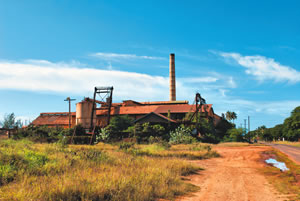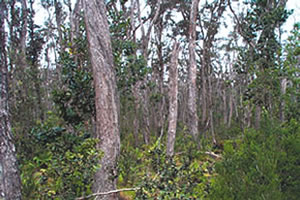Powering The Island With Biomass

Kekaha mill is undergoing a cleanup and will eventually house a 20-megawatt biomass power plant
The old Kekaha sugar mill is slated to be the site of a 20-megawatt biomass power plant
Generating approximately 25 percent of the island’s electrical needs and employing some 200 people, Pacific West Energy plans to develop a renewable energy project at the former sugar plantation site Kekaha mill.
Current cleanup efforts at the location are in conjunction with Pacific West’s intent to use the 23-acre industrial-zoned site for a $100 million renewable energy project that will serve as a support base for the “revitalization of agricultural operations,” says Pacific West executive vice president and Kaua’i Land and Mill manager Scott Matsuura.
With this base, in addition to biomass, the site also would be able to support other renewable energy projects like solar, hydro and algae.
“We’re in discussions with Pacific West, but have no agreements at this time,” says Kaua’i Island Utility Cooperative spokesperson Shelly Paik.
Though there have been no official arrangements thus far, Pacific West would provide its generated energy to the co-op, ultimately resulting in a decrease of more than 350,000 barrels of imported petroleum to Kaua’i and a retention of some $30 million in the local economy, according to Matsuura.
In addition, the company intends to lease agricultural lands on Kaua’i to cultivate biomass crops and encourage private farmers to produce crops for renewable energy production to help Kaua’i become energy self-sufficient.
The first phase of the project will include the biomass power plant and other supporting agricultural development. Phase two will involve the creation of a biofuels facility that will help meet the state’s renewable fuel requirements.

Pacific West Energy plans to use crops like this to supply 25 percent of Kaua'i's energy/Pacific West Energy plans to use crops like this to supply 25 percent of Kaua'i's energy
“The project will produce green electricity from bio-mass, backing out approximately 15 million gallons of diesel oil per annum and, as part of phase two, produce clean renewable fuels for blending in motor fuel,” says Matsuura.
The removal of equipment and site remediation at the Kekaha mill will take approximately nine to 12 months.
“Since the Kekaha sugar mill ceased operations nearly a decade ago, the site has sat idle and the infrastructure deteriorated,” states Matsuura. “The old mill was left with asbestos and other environmental hazards, and since its closure has been subject to corrosion, vandalism, and become a dumping ground for old cars, batteries and the like.”
Though the date of the project’s final completion is undetermined at this time, the project’s assembly period should result in more than 150 direct construction-related jobs and more than 625 direct and indirect jobs.
“The Kekaha site will be the home of a new industrial facility, with additional buildings, properly maintained landscaping and state-of-the-art equipment,” says Matsuura, who has been involved in the plantation industry for almost 30 years on Kaua’i and Maui.
Not only will the future enterprise help Kaua’i become less dependent upon oil, the business plans to operate in an environmentally friendly manner.
All liquid effluent will be recycled, and the irrigation system will be top-notch. Furthermore, operations at the former Kekaha mill to be acquired by Kaua’i Land and Mill, an affiliate of Pacific West, will not include crop burning.
“The project will become a model of an integrated renewable-energy facility, utilizing local resources for local energy needs, while developing new economic opportunities and diversifying the local economic base,” according to Pacific West.
While Kaua’i Industries has organized the clean-up and removal of equipment at the Kekaha and Lihu’e mills simultaneously, unlike Kekaha, there are currently no final site plans for Lihu’e, says PAHIO Development president Lynn McCrory.
There are eventual plans to remove the dilapidated buildings at the Lihu’e mill, but no definitive date is set.
“The cleanup of both Lihu’e and Kekaha mill sites will be a positive step toward either or both sites becoming an economic generator for the island,” she says.
Though the transition from the plantation era on Kaua’i meant many good, hardworking people lost their jobs and bountiful agricultural land no longer used, assisting with a project “that intends to transform these areas back to productive, sustainable uses is exciting and an emotional time,” Matsuura says. “These types of efforts should make Kaua’i a leader in the state and provide further economic stimulus for all of Kaua’i to enjoy.”
You must be logged in to post a comment.




There are no comments
Add yours